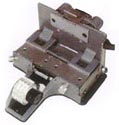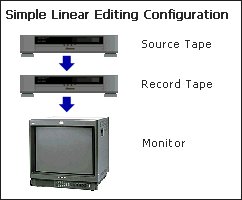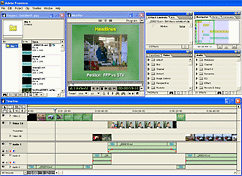There are several different ways to edit video and each method has its pros and cons. Although most editors opt for digital non-linear editing for most projects, it makes sense to have an understanding of how each method works. This page provides a very brief overview of each method — we will cover them in more detail in other tutorials. Traditionally, film is edited by cutting sections of the film and rearranging or discarding them. The process is very straightforward and mechanical. In theory a film could be edited with a pair of scissors and some splicing tape, although in reality a splicing machine is the only practical solution. A splicing machine allows film footage to be lined up and held in place while it is cut or spliced together. Linear editing was the original method of editing electronic video tapes, before editing computers became available in the 1990s. Although it is no longer the preferred option for most serious work, it still has a place and remains the better option in some cases. It is likely that linear editing will be a useful skill for a long time to come. The idea is to record only those parts of the source tape you want to keep. In this way desired footage is copied in the correct order from the original tape to a new tape. The new tape becomes the edited version. This method of editing is called "linear" because it must be done in a linear fashion; that is, starting with the first shot and working through to the last shot. If the editor changes their mind or notices a mistake, it is almost impossible to go back and re-edit an earlier part of the video. However, with a little practice, linear editing is relatively simple and trouble-free. Non-linear editing has many significant advantages over linear editing. Most notably, it is a very flexible method which allows you to make changes to any part of the video at any time. This is why it's called "non-linear" — because you don't have to edit in a linear fashion. One of the most difficult aspects of non-linear digital video is the array of hardware and software options available. There are also several common video standards which are incompatible with each other, and setting up a robust editing system can be a challenge. The effort is worth it. Although non-linear editing is more difficult to learn than linear, once you have mastered the basics you will be able to do much more, much faster. In some situations multiple cameras and other video sources are routed through a central mixing console and edited in real time. Live television coverage is an example of live editing. Live editing is a fairly specialist topic and won't concern most people. Next Page: Video Editing TerminologyFilm Splicing
 Technically this isn't video editing, it's film editing. But it is worth a mention as it was the first way to edit moving pictures and conceptually it forms the basis of all video editing.
Technically this isn't video editing, it's film editing. But it is worth a mention as it was the first way to edit moving pictures and conceptually it forms the basis of all video editing.Tape to Tape (Linear)
 In linear editing, video is selectively copied from one tape to another. It requires at least two video machines connected together — one acts as the source and the other is the recorder. The basic procedure is quite simple:
In linear editing, video is selectively copied from one tape to another. It requires at least two video machines connected together — one acts as the source and the other is the recorder. The basic procedure is quite simple:Digital/Computer (Non-linear)
 In this method, video footage is recorded (captured) onto a computer hard drive and then edited using specialized software. Once the editing is complete, the finished product is recorded back to tape or optical disk.
In this method, video footage is recorded (captured) onto a computer hard drive and then edited using specialized software. Once the editing is complete, the finished product is recorded back to tape or optical disk.Live Editing
29 Januari 2010
 Different Types of Video Editing
Different Types of Video Editing
oleh
Belajar IT
Label:
video editing
Langganan:
Posting Komentar (Atom)




































0 komentar:
Posting Komentar